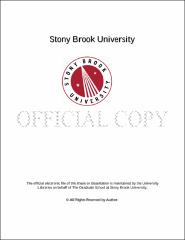| dc.identifier.uri | http://hdl.handle.net/11401/76743 | |
| dc.description.sponsorship | This work is sponsored by the Stony Brook University Graduate School in compliance with the requirements for completion of degree. | en_US |
| dc.format | Monograph | |
| dc.format.medium | Electronic Resource | en_US |
| dc.language.iso | en_US | |
| dc.publisher | The Graduate School, Stony Brook University: Stony Brook, NY. | |
| dc.type | Dissertation | |
| dcterms.abstract | The main topic of this thesis is the study of the spectral properties of the Dirac operator of Lattice Quantum Chromodynamics (QCD). Lattice QCD is the main regularization for ab initio non-perturbative calculations and despite the fact that it is almost four decades old, the spectral properties of the Dirac operator have not been fully understood. The main effort of this thesis is to study analytically the low lying Dirac eigenvalues with the use of Random Matrix Theory techniques. A full analytical control of this part of the spectrum may be helpful to avoid problems of lattice simulations in the deep chiral regime. The first chapter contains a derivation of the joint probability distribution of the eigenvalues of the Wilson Dirac operator which is the master quantity for the derivation of all spectral correlation functions. Explicit results of the density of the complex eigenvalues, the density of the real eigenvalues as well as the distribution of the chiralities over the real eigenvalues are provided. In this analysis we have included the Low Energy Constants (LECs) that enter in the leading order of the Symanzik expansion. We describe the effects of the LECs on the spectrum and we provide novel relations which would allow for their determination from lattice data. Next we consider the Hermitian Wilson Dirac operator of QCD-like theories. In particular we consider the case of two color QCD with fundamental quarks as well as any color QCD with adjoint quarks. We derive the partition function of these theories and calculate analytically and numerically the microscopic spectral density and provide bounds for the spectral density of the real eigenvalues of the corresponding Non-Hermitian Wilson Dirac operator. In the last chapter we consider the two-dimensional Dirac operator and different gauge groups as well as number of colors and also even-even, odd-odd and mixed spacetime lattices. We classify these theories in terms of random matrix theories. Analytical results for the microscopic spectral density of each particular case are compared with lattice simulations. | |
| dcterms.available | 2017-09-20T16:51:06Z | |
| dcterms.contributor | Verbaarschot, Jacobus | en_US |
| dcterms.contributor | Creutz, Michael | en_US |
| dcterms.contributor | Goldman, Vladimir | en_US |
| dcterms.contributor | Heller, Urs. | en_US |
| dcterms.creator | Zafeiropoulos, Savvas | |
| dcterms.dateAccepted | 2017-09-20T16:51:06Z | |
| dcterms.dateSubmitted | 2017-09-20T16:51:06Z | |
| dcterms.description | Department of Physics. | en_US |
| dcterms.extent | 192 pg. | en_US |
| dcterms.format | Monograph | |
| dcterms.format | Application/PDF | en_US |
| dcterms.identifier | http://hdl.handle.net/11401/76743 | |
| dcterms.issued | 2015-08-01 | |
| dcterms.language | en_US | |
| dcterms.provenance | Made available in DSpace on 2017-09-20T16:51:06Z (GMT). No. of bitstreams: 1
Zafeiropoulos_grad.sunysb_0771E_11474.pdf: 2380119 bytes, checksum: ebb7dd18798312f0d456b75ea83dc46b (MD5)
Previous issue date: 2013 | en |
| dcterms.publisher | The Graduate School, Stony Brook University: Stony Brook, NY. | |
| dcterms.subject | Chiral Symmetry, Dirac Spectrum, Lattice QCD, Non Perturbative QCD, Random Matrix Theory, Wilson Dirac Operator | |
| dcterms.subject | Physics | |
| dcterms.title | Random Matrix Theories for Lattice QCD Dirac Operators | |
| dcterms.type | Dissertation | |

